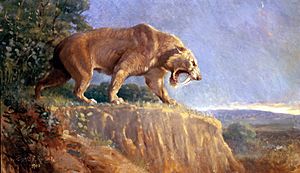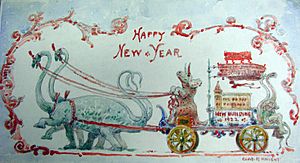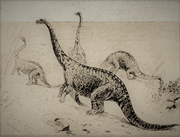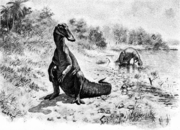Charles R. Knight facts for kids
Quick facts for kids
Charles R. Knight
|
|
|---|---|
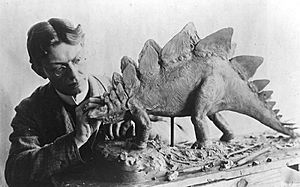
Charles R. Knight working on Stegosaurus in 1899
|
|
| Nationality | American |
| Known for | Painting |

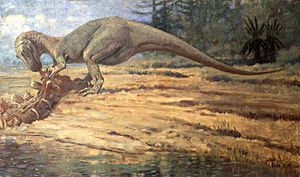
Charles Robert Knight (born October 21, 1874 – died April 15, 1953) was an American artist. He became famous for his amazing paintings of dinosaurs and other prehistoric animals.
His artwork appeared in many books. You can still see his paintings in several big museums across the United States.
Contents
Early Life and Art
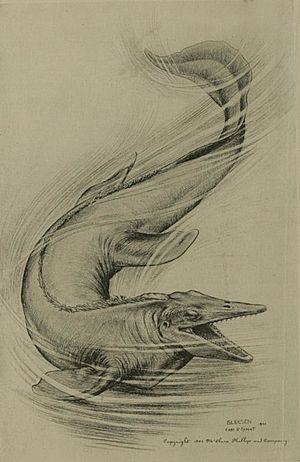
When Charles Knight was a kid, he loved nature and animals. He spent hours copying pictures from his father’s natural history books. Even though he had very poor eyesight, he could still see enough to draw. He had a severe eye problem called astigmatism and later injured his right eye. But special glasses helped him. At age twelve, he started studying art at the Metropolitan Art School. He wanted to become a commercial artist.
In his free time, Knight often visited the American Museum of Natural History. There, a scientist named Dr. Jacob Wortman noticed his talent. Soon, the museum asked Knight to create a series of watercolor paintings for their fossil exhibits.
These paintings became very popular with museum visitors. Knight kept working with the museum until the 1930s. He painted some of the most famous pictures of dinosaurs, ancient mammals, and early humans.

One of Knight's most well-known paintings for the American Museum of Natural History is Leaping Laelaps from 1897. This painting was special because it showed dinosaurs as active, fast-moving creatures. This was a new idea for its time, long before modern paleontologists like Robert Bakker shared similar views.
Other famous paintings at the American Museum include Knight’s pictures of Agathaumas, Allosaurus, Brontosaurus, Smilodon, and the Woolly Mammoth. Many of these have been copied and shared countless times.
Art Across the Country
Soon, natural history museums all over the country wanted Knight to paint for them. They needed his artwork as backgrounds for their own fossil displays. In 1925, Knight created a large mural for the Natural History Museum of Los Angeles County. This mural showed some of the birds and mammals whose bones were found in the nearby La Brea Tar Pits.
The next year, Knight started a huge project for Chicago’s Field Museum of Natural History. He painted 28 murals showing the history of life on Earth. This project took him four years to finish. At the Field Museum, he painted one of his most famous pieces. It showed a fierce battle between a Tyrannosaurus and a Triceratops. This scene of a predator and its prey inspired many other artists. It also made Tyrannosaurus and Triceratops famous as 'mortal enemies' in people's minds.
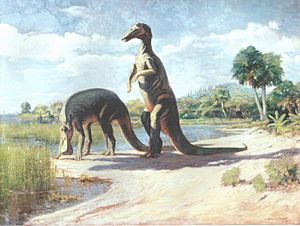
Knight’s work also went to the Carnegie Museums in Pittsburgh. His art was also displayed at the Smithsonian Institution in Washington D.C. and Yale's Peabody Museum of Natural History. Several zoos, like the Bronx Zoo and the Lincoln Park Zoo, also asked Knight to paint murals of their living animals.
Knight also drew pictures for books and magazines. He often contributed to National Geographic magazine. He even wrote and illustrated several of his own books. These included Life Through the Ages (1946) and Prehistoric Man: The Great Adventure (1949). Knight also became a popular lecturer. He traveled around the country, telling audiences about prehistoric life.
Knight's Legacy and Discoveries
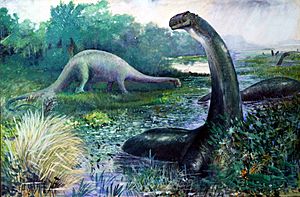
Charles Knight worked at a time when many new dinosaur fossils were being found. These fossils often came from the American West. Because of this, not all of his paintings were based on complete information. As science grew, some of his ideas about dinosaurs were updated.
For example, he sometimes painted plant-eating dinosaurs like ceratopsians alone in grassy areas. But scientists later learned that these dinosaurs likely lived in groups. Also, the wide open grasslands he painted didn't appear until much later in Earth's history.
Knight often drew dinosaurs with limbs and hips that looked like modern reptiles. However, by the 1920s, paleontologists had found that dinosaurs actually had wider, bird-like hips.
While Knight often showed extinct mammals and marine reptiles in active poses, his large dinosaurs sometimes looked slow and heavy. He even described them as "slow-moving dunces." But we now know that many large plant-eating dinosaurs were quite successful. They survived for a long time in a world full of predators.
The Dinosaur Tail Mystery
One common mistake in Knight's dinosaur paintings was not his fault. It was an idea shared by all paleontologists of his time. They didn't realize that a dinosaur's tail was used for balance. So, when a dinosaur moved, its tail was held out straight, not dragged on the ground. In many dinosaur species, the tail bones were even stiffened, meaning the tail had to be held horizontally. Deinonychus is a good example of this.
This misunderstanding, which was not Knight's fault, means some of his best illustrations look a bit different from what we know today.
Famous Fans
Many people admired Charles Knight's work. One famous fan was special effects artist Ray Harryhausen. Harryhausen created amazing stop-motion monsters for movies. He said that Knight "put flesh on creatures that no human had ever seen." Knight's murals and books helped Harryhausen when he made his own models of extinct animals.
Modern Books and Art
Even though many other paleoartists have come after Knight, his paintings are still very popular. People who love paleontology enjoy his work.
- A special edition of Knight’s 1946 book Life Through the Ages was recently published by Indiana University Press ISBN: 978-0-253-33928-7.
- A 2007 calendar ISBN: 978-0-7649-3622-7 featuring Knight’s paintings is also available.
- Fantasy artist William Stout has been collecting Knight's rare and unpublished drawings in a series called Charles Knight Sketchbooks.
Images for kids
-
Knight working on Stegosaurus in 1899.
-
A bison on the 1901 United States ten-dollar bill, drawn by Knight.
-
Tylosaurus from 1899.
See also
 In Spanish: Charles R. Knight para niños
In Spanish: Charles R. Knight para niños


